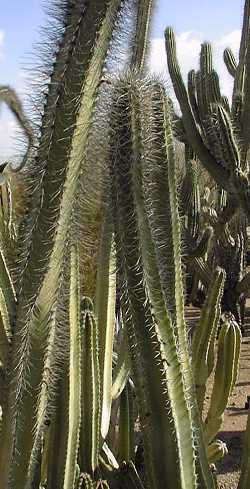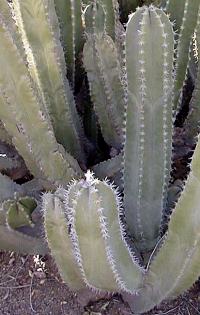Senita, Whisker Cactus
Scientific Name: Pachycereus schottii (Engelm.) D.R. Hunt
Synonym: Cereus mieckleyanus, Cereus sargentianus, Cereus schottii var. australis , Cereus schottii, Lophocereus australis, Lophocereus sargentianus, Lophocereus schottii, Lophocereus schottii, Lophocereus schottii var. sargentianus , Lophocereus schottii var. australis , Lophocereus schottii var. tenuis , Pachycereus schottii var. tenuis , Pachycereus schottii, Pachycereus schottii, Pilocereus sargentianus, Pilocereus schottii
Family: Cactaceae
USDA: 9-10
Frost Tolerance: 15°F (-9°C) for Arizona clones, but the growing tips need protection. The monstrose form is more frost sensitive and should not be at less than 25°F (-4°C)
Heat Tolerance: Resistant in Phoenix
Sun Exposure: Full sun
Origin: Southwest USA (Arizona), northwestern Mexico (Baja California, Sonora)
Growth Habits: Columnar, basally branching, slow growing up to 12 feet tall (3.6 m). Stems 4 to 8 inches in diameter (10 to 20 cm); 5 to 10 ribs; areoles on the bottom part of the stems are woolly, oval, 0.12 to 0.2 inch wide (3-5 mm), with one to 15 spines, 0.1 to 0.3 inch long; upper areoles 0.3 to 0.6 inch wide (7-15 mm), 20 to 75 spines , 1.2 to 4 inches long (3-10 cm).
Watering Needs: Little to no water for established specimen when used in landscape. Specimens in the wild receive both winter and late summer rain.
Propagation: Cuttings in summer, offsets, seeds

Pachycereus schottii 'Monstrose'
The form 'Monstrosus' also described as 'forma mieckleyanus' for the thinner types or 'fa obesa' for the thicker more tubercled types is native to Baja California. Its strange, mostly spineless shape (picture 2) can be very attractive for landscape use. It is also less frost resistant, and should be protected below 25°F (-4°C)

Blooming Habits:
The senita blooms at night at the end of the spring in the 'hairy' part of the stems. The flowers are light pink, up to 1.6 inches in diameter (4 cm). They close around mid-morning. The Senita blooms most of the year, mainly from April to September. The edible fruit is red, with a red pulp.
Desert-Tropicals is dedicated to provide gardening advice, gardening ideas, and information about flower of all kind for landscape and collections.We try to check carefully the identification of the plants on the illustrations as well as the other information from the page, but occasionally errors do occur. if you notice anything that needs to be changed please contact us.Thanks.
© 1998-2020 Philippe Faucon, All Rights Reserved.
